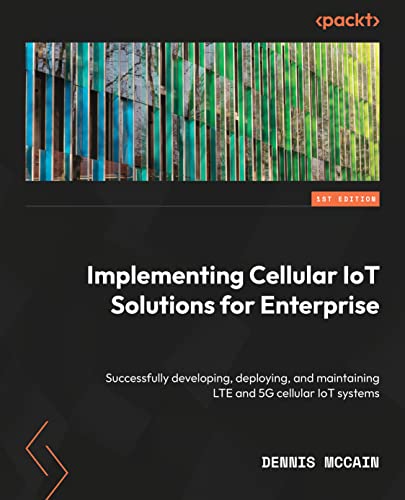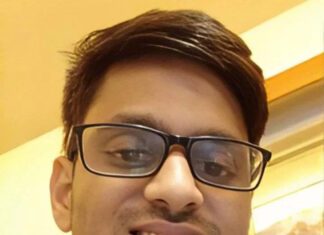Dennis McCain is the author of Implementing Cellular IoT Solutions for Digital Transformation, we got the chance to sit down and find out more about his experience of writing with Packt.
Q: What are your specialist tech areas?
Dennis: LTE/5G cellular, Internet of Things, Wireless technologies
Q: How did you become an author for Packt? Tell us about your journey. What was your motivation for writing this book?
Dennis: Having worked in the IoT over the past 20 years and developing cellular IoT solutions over the past 5 years, I have a passion for the IoT and saw a need for a practical guide on the various aspects of cellular IoT to help enable cellular IoT solutions. When Packt approached me in early 2022 to write a book on implementing cellular IoT solutions, I was excited to start my journey as an author.
Q: What kind of research did you do, and how long did you spend researching before beginning the book?
Dennis: I did some research on the cellular IoT markets to give my readers a “why” for pursuing a cellular IoT solution. Having worked in various IoT markets and technical roles over the past 20 years with more than 5 years working in cellular IoT, I had most of the knowledge about the IoT devices, architectures, and wireless technologies as well as the best practices to follow along the IoT journey.
Q: Did you face any challenges during the writing process? How did you overcome them?
Dennis: I thought collaborating with colleagues on writing the book would make the process easier, but I found with delays and rewrites, it was much better for me to be the sole writer. The saying “If you want something done right, do it yourself” comes to mind.
Q: What’s your take on the technologies discussed in the book? Where do you see these technologies heading in the future?
Dennis: I am passionate about LTE Low Power Wide Area (LPWA) and new 5G cellular technologies driving the growth of IoT solutions in many markets over the next 10 years. This is primarily driven by the lower cost and low power features of cellular technologies compared to 10 years ago in addition to the inherent benefits of global coverage and performance with LTE and 5G. We are now seeing licensed cellular technologies overtaking unlicensed WWAN and WLAN technologies in IoT solutions for many reasons described in the book, and this trend will continue with a strong cellular IoT ecosystem of partners.
Q: Why should readers choose this book over others already on the market? How would you differentiate your book from its competition?
Dennis: I found that other IoT books on the market were either too technical with little or no focus on the practical IoT markets and best practices or too high-level with little or no practical knowledge on all of the key aspects of an IoT solution. I think my book fills this gap by providing foundational knowledge on all aspects of any IoT solution as well as real-world best practices for implementing IoT solutions especially those based on cellular technologies.
Q: What are the key takeaways you want readers to come away with from the book?
Dennis: I would like my readers to come away with a good knowledge of the IoT wireless technologies, devices, and architectures as well as the key IoT markets, use-cases, business models, and trends. My goal in writing this book is to provide a practical guide to enable my readers to successfully implement robust IoT solutions in all IoT markets.
Q. What advice would you give to readers learning tech? Do you have any top tips?
Dennis: To stay abreast of the latest technology trends, I would advise readers to read technical books, technology news/websites, market reports, and technical blogs on the relevant technology. There is a wealth of technical knowledge on practically any topic that is readily available from many sources online.
Q. Do you have a blog that readers can follow?
Dennis: Other than my LinkedIn postings, I really don’t currently have a blog that readers can follow.
Q. Can you share any blogs, websites and forums to help readers gain a holistic view of the tech they are learning?
Dennis: From an IoT perspective, there are many blogs and websites that readers can follow. Here are some that I follow.
– IoT Now – www.iot-now.com
– IoT World Today – www.iotworldtoday.com
– IoT Business News – iotbusinessnews.com
– IoT Analytics – iot-analytics.com
– Stacey on IoT – staceyoniot.com
Since IoT is broad bridging many markets and technologies, I would focus on a few specific markets and technologies.
Q. How would you describe your author’s journey with Packt? Would you recommend Packt to aspiring authors?
Dennis: I really enjoyed working with Packt on the book. Everyone at Packt was very supportive on my journey and made the writing enjoyable. I would definitely recommend Packt to other aspiring authors.
Q. Do you belong to any tech community groups?
Dennis: I joined several IoT groups on LinkedIn to stay abreast of IoT trends.
Q. What are your favorite tech journals? How do you keep yourself up to date on tech?
Dennis: Given that I am actively working with partners and customers on cellular IoT solutions in my role at AT&T, I am at the forefront of IoT technology trends and markets. I also read IoT news and listen to IoT podcasts to stay current on both the IoT technologies and markets.
Q. How did you organize, plan, and prioritize your work and write the book?
Dennis: I planned on researching and writing a chapter every 2 weeks doing most of my writing on the weekends. This gave me time to organize what I wanted to present in the chapter and research accordingly.
Q. What is that one writing tip that you found most crucial and would like to share with aspiring authors?
Dennis: If you write about something for which you are passionate, the writing will be enjoyable and the content will be easy.
You can find Dennis’ book on Amazon by following this link: Please click here









